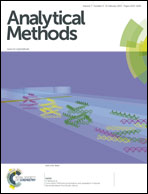Concurrent DNA preconcentration and separation in bipolar electrode-based microfluidic device†
Abstract
This paper presents a bipolar electrode (BPE) device in a microfluidic dual-channel design for concurrent preconcentration and separation of composite DNA containing samples. The novelty of the present effort relies on the combination of BPE-induced ion concentration polarization (ICP) and end-labeled free-solution electrophoresis (ELFSE). The ion concentration polarization effect arising from the faradaic reaction on the BPE is utilized to exert opposing electrophoretic and electroosmotic forces on the DNA samples. Meanwhile, end-labeled free-solution electrophoresis alters the mass–charge ratio to enable simultaneous DNA separation in free solution. The microfluidic device was fabricated using standard and soft lithography techniques to form gold-on-glass electrode capped with a PDMS microfluidic channel. Experimental testing with various DNA samples was carried out over a range of applied electric field. Concentration ratios up to 285× within 5 minutes for a 102-mer DNA, and concurrent preconcentration and free-solution separation of binary mixture of free and bound 102-mer DNA within 6 minutes was demonstrated. The effect of applied electric field was also interrogated with respect to pertinent performance metrics of preconcentration and separation.

- This article is part of the themed collection: Microfluidics Research 2015-2016

 Please wait while we load your content...
Please wait while we load your content...